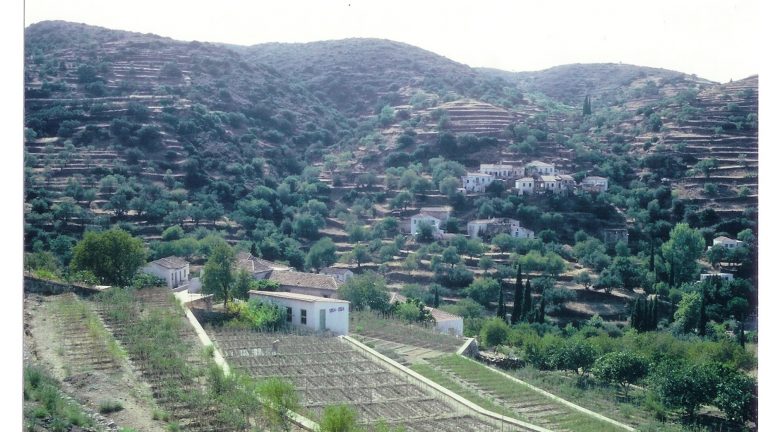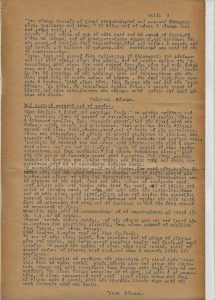ΓEΩPΓIKA NEA nr. 2
In the Georgika Nea – (Agricultural News – Monthly newsletter no. 2), an article by Georgios Kalligeros, agricultural engineer about visible deceases in trees and articles by George and Anna Koksma.
These are the articles penned by George Koksma and a Recipe by his wife Anna.
(Translation by Emmanuel Alfieris, Australia, March 2018)
Penicillin in milk is a public health risk
It is well known that some people, approximately 10%, are allergic to penicillin. In some cases these allergies cause severe anaphylaxis and may result in death. Recently in our country there has been a number of penicillin related anaphylactic shock deaths. This has caused concern amongst the medical community and an urgent conference with experts has been arranged to calm community fears.
Penicillin allergic reactions do not present only from antibiotics delivered by doctors, but also with individuals that have never had penicillin medicine. So where could this allergic reaction originate? These cases are from milk produced from animals that have had penicillin treatment for mastitis.
English, Swedish and American studies show that milk from cows that have undergone penicillin treatment for mastitis, contain significant levels of penicillin for 36-72 hours after milking. The penicillin is active in enzymes that are present in cheese production. This reduces volume of dairy product output but is also extremely dangerous to public health if consumed by people with penicillin allergy. The amount of penicillin present in this contaminated milk is the equivalent of two penicillin medicine dosages administered by a doctor.
(more in the next issue)
The economic importance of forests and forestry problems
The importance of forests in our area is enormous and has a dual role – ecosystem and economic. Forests’ ecosystem role is due to its protective characteristics on agricultural land ground cover and for regulating water flow. It’s second role derives from the direct economic benefits resulting from forestry products that are irreplaceable and necessary for human life.
I will require a lot of space to expand on the benefits forests provide so I won’t attempt to do so. However, I ask our reader to reach your own conclusions taking into account the enormous water deluge damages on cultural buildings, roads, bridges etc., human life, drownings, on agriculture, covering arable land with rocks etc. These would not occur if the catchment areas, that feed the deluge, were covered with forests.
The reader will also be able to understand the direct economic benefits from forestry products for construction, paper, wood materials, fuel etc, etc, etc that have followed us throughout civilisation and whose demand continues to increase.
(more in the next edition)
The Unit’s seasonal activities
It’s been a while since I’ve written something. I used to write for the “Servant” and now I write for the “Agricultural News” together with government employees. I think this is much better.
I won’t write a lot as there are many ongoing projects and development continues even if some people are leaving. Presently, we’re working on the Mylopotamos college, the bell tower there, a hotel, the Old Persons Home, stables at Kalamos, Agia Anastasia, Mylopotamos, Hora etc.
Now may be a good time to inform you, that our stables programme is full at present. Of course, we have sent letters for further assistance and have no doubt it will be forthcoming. But at this stage, unfortunately we have to STOP.
However, the major plans are the Agia Anastasia agricultural fields where we are continuously exploring exceptional things for common life. Do you know that we have produced sugar from carob flour, do vinegar trials, dried pears? That we have done trials with grape juice? Yes, some people are odd and say, “What does Koksma want and what is he doing at his fields?”. Well I’m actually trying to find all good that can be spread across all of Kythera to rejuvenate agriculture and I’m sorry that I can’t work more there as I don’t have the time, and especially the funds. I’ll advise you all of all good results.
We also have some other plans. E.g. the water facility at Avlemonas, which in turn is part of a larger Paleopolis plan. This is a very important project, not just for the locals who have fields and trees, but for the whole island. I hope we will be abler to write positive and impressive news next time. In the meantime, we have news from Agios Theodoros. Let’s see and be a little patient. Time passes you know. Finally I wish you good progress and good olive harvesting.
George Koksma
A recipe for the fields
The olive harvest season is starting. A major problem for women is what food to prepare while in the fields. Of course Greek cuisine has many dishes, however, this season there is not a lot of time for cooking. When we’re harvesting olives we want simple, easy and cheap satiating food. Are you interested in knowing what Dutch farmers wives cook when they’re in the fields working? Listen to my simple recipe. This recipe is for 16 servings. We call the dish “Fry” – plakounta (Ii Dutch – pannenkoek) You may ask for how many people, but as you know, this depends on how many servings your workers eat. Some eat for one, others for three and others more. You have to work this out yourselves.
The recipe:
You need –
- 1/2 kg flour,
- 1 kg milk
- A little salt
- 2 eggs
Put the flour and the salt into a bowl and pour the milk as you continuously mix. When it melts well, add the eggs, but again you have to shake well. Then you add oil to the pan, but not a lot, and you put it on the fire to heat well, to burn (it doesn’t work with cold oil). Now that the oil is very hot, pour a tea cup of mixture. We leave in the pan for 2-3 minutes until it darkens underneath and then we flip over to fry the other side the same.
Now you can complement with many ingredients. E.g.
- With salami. Cut thin slices, cook in the hot oil and add a cup of mixture. Cook as I’ve written and it’s ready.
- With tomatoes, sour cheese and salty olives. When the oil is hot, add a cup of mixture into the pan and add small pieces of tomato, olives and sour cheese on top. The fire shouldn’t be too hot as the food needs to cook slowly and you don’t flip the mixture in this version.
- You can also make like a sweet. In Holland, this is how they often eat it. Add two spoons of sugar in the mixture and then continue as I described in the beginning. When you see that it’s ready, you can eat with honey or marmalade, a truly fantastic sweet. And you can have it cold or hot.
And after your success, Kali orexi.
Anna Koksma
Click on the document to enlarge
Click here for Georgika Nea nr 1



